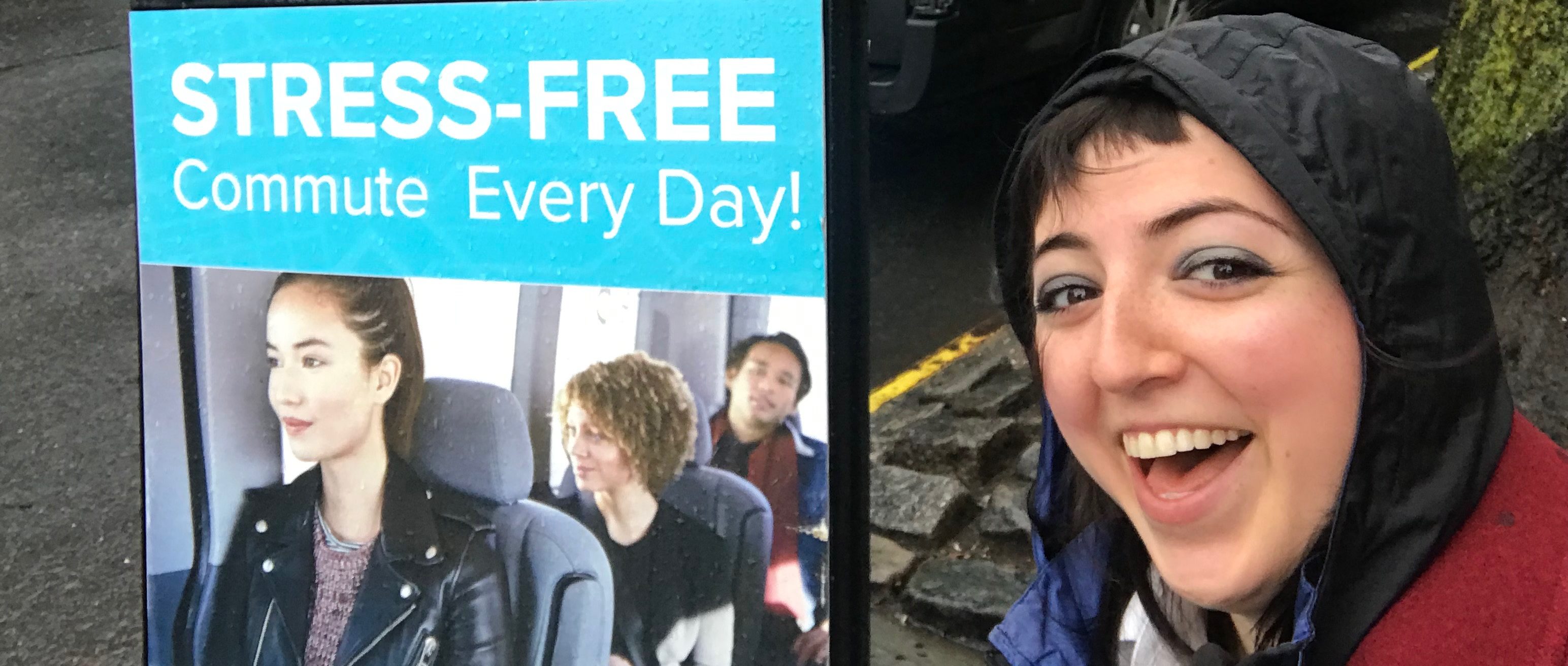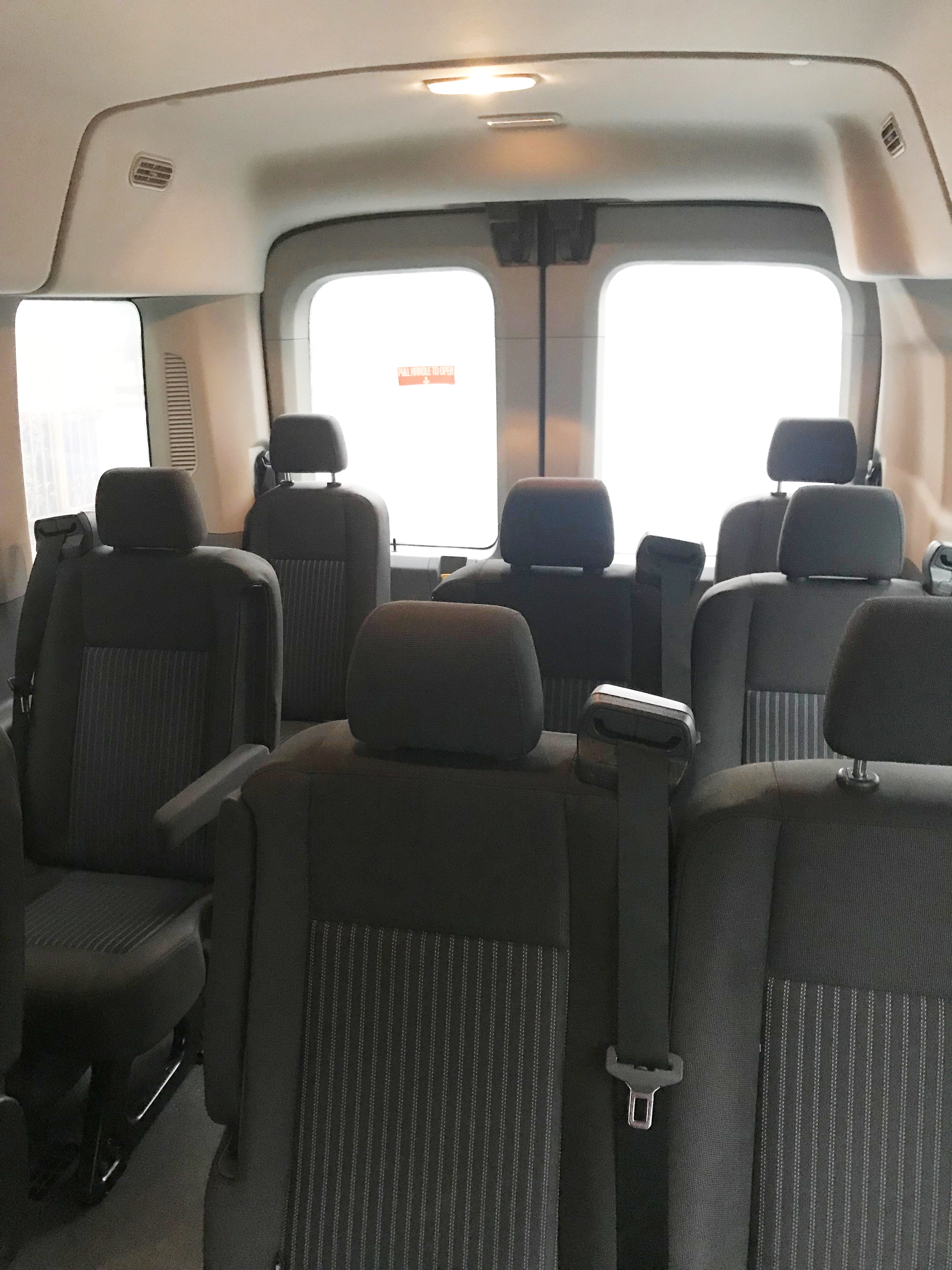
A dispatch from the “micro-transit” beat in Greenpoint, Brooklyn, by Joelle Ballam-Schwan
A death-knell for public transportation recently sounded by right wing anti-transit pundit Randall O’Toole laid falling ridership at the feet of “the success of competitors such as Uber, Lyft and Chariot.” We know Uber & Lyft are siphoning some transit riders away. But at present we can say definitively that Chariot is not, not in Northern Brooklyn.
Every day I am confronted by janky Chariot sandwich boards chained to MTA bus stop signs advertising a “Stress-Free Commute” from Williamsburg to the Financial District for $4, and by the company’s blue vans’ presence in the noticeably worsening traffic of Greenpoint. The boards advertise a stress-free, comfortable, and revolutionized commute.
Chariot is a species of “micro-transit.” Transit experts are so dubious about the idea of small vehicles and flexible routes serving big-city needs that the concept earned a brutal “MicroTransit Week” on Jarett Walker’s blog in February. Even so, I discovered that a new route would take me nearly door-to-door from home to work. Despite my horoscope warning: “new technologies are certain to exceed all your pre-existing notions of disappointment” I decided to give “commuting in comfort” a shot.
My regular subway commute has one human sardine can option and one lengthy/awkward alternative. One: bus, walk or Citibike 0.6 miles to the L train, transfer to downtown 4/5 at Union Square averaging 40 minutes; Two: walk 0.2 miles to the G train, get out at Fulton and walk three blocks to Atlantic Terminal for the Manhattan-bound 4/5, averaging 55 minutes. More-often than not I opt for the latter. The G’s extra room allows me to Duo-Lingo or read without wildly inconveniencing fellow passengers. But could Chariot possibly provide me an option without these tradeoffs?
No, it cannot.
The sandwich boards promised me a van full of diverse and attractive passengers and a smooth, fast ride. This turned out to be false advertising.
Chariot has the neat trick of only selling fares in $8 increments, so I rode it on two mornings. On the first try, I was the only passenger. On the second, I had one companion commuter. The Chariots I witness in Greenpoint over the past year have always appeared empty, and they have certainly never disgorged a crowd at the MTA bus stops they use. But until now their tinted windows have relegated the no-rider theory to mere suspicion.
The fact that there were no other passengers or stops allowed us to cruise through Williamsburg, and I started to think that Chariot might in fact yield major time savings. But once we hit the Williamsburg Bridge, the jig was up. Like anyone trying to make time on the streets of New York, the driver drove cabbie-style, jerking in and out of lanes, accelerating into open street then hitting the brakes. Although the lack of additional passengers provided ample space, the driving (plus potholes) was not conducive to simple things like tweeting from my phone. For me, that kind of trip is certainly far from stress-free and precipitates motion sickness. The full commute, door-to-door, was an hour; 10 minutes longer than my G train commute with its walking transfer.
Chariot operates in a small handful of cities – most notably San Francisco, where it sees a few thousand riders per day. There, it has garnered enough of a rap for poaching Muni riders that a new set of city regulations governing its operations was recently instituted. Chariot was purchased by Ford Motor Co. in September of 2016 as part of the company’s experimentation with elements of a new business model. No one knows how long Ford will pay to run riderless vans around NYC as it works out what “smart mobility” actually consists of.
Chariot’s CEO has indicated, and its route map suggests that the company is hoping to gain a New York foothold during the L train shutdown that starts next year. Maybe that will add riders, but if transit lanes (that allow vans like Chariot) aren’t retained on the Williamsburg Bridge after the train re-opens, it’s hard to see who will stick with it.

 On the Brink: Will WMATA’s Progress Be Erased by 2024?
On the Brink: Will WMATA’s Progress Be Erased by 2024?
The experience of being a WMATA rider has substantially improved over the last 18 months, thanks to changes the agency has made like adding off-peak service and simplifying fares. Things are about to get even better with the launch of all-door boarding later this fall, overnight bus service on some lines starting in December, and an ambitious plan to redesign the Metrobus network. But all of this could go away by July 1, 2024.
Read More Built to Win: Riders Alliance Campaign Secures Funding for More Frequent Subway Service
Built to Win: Riders Alliance Campaign Secures Funding for More Frequent Subway Service
Thanks to Riders' Alliance successful #6MinuteService campaign, New York City subway riders will enjoy more frequent service on nights and weekends, starting this summer. In this post, we chronicle the group's winning strategies and tactics.
Read More